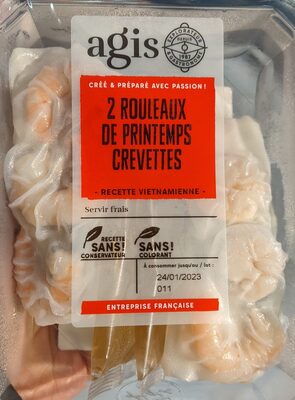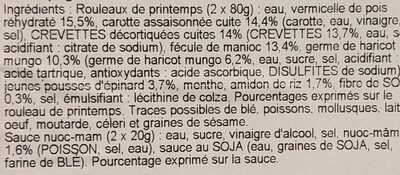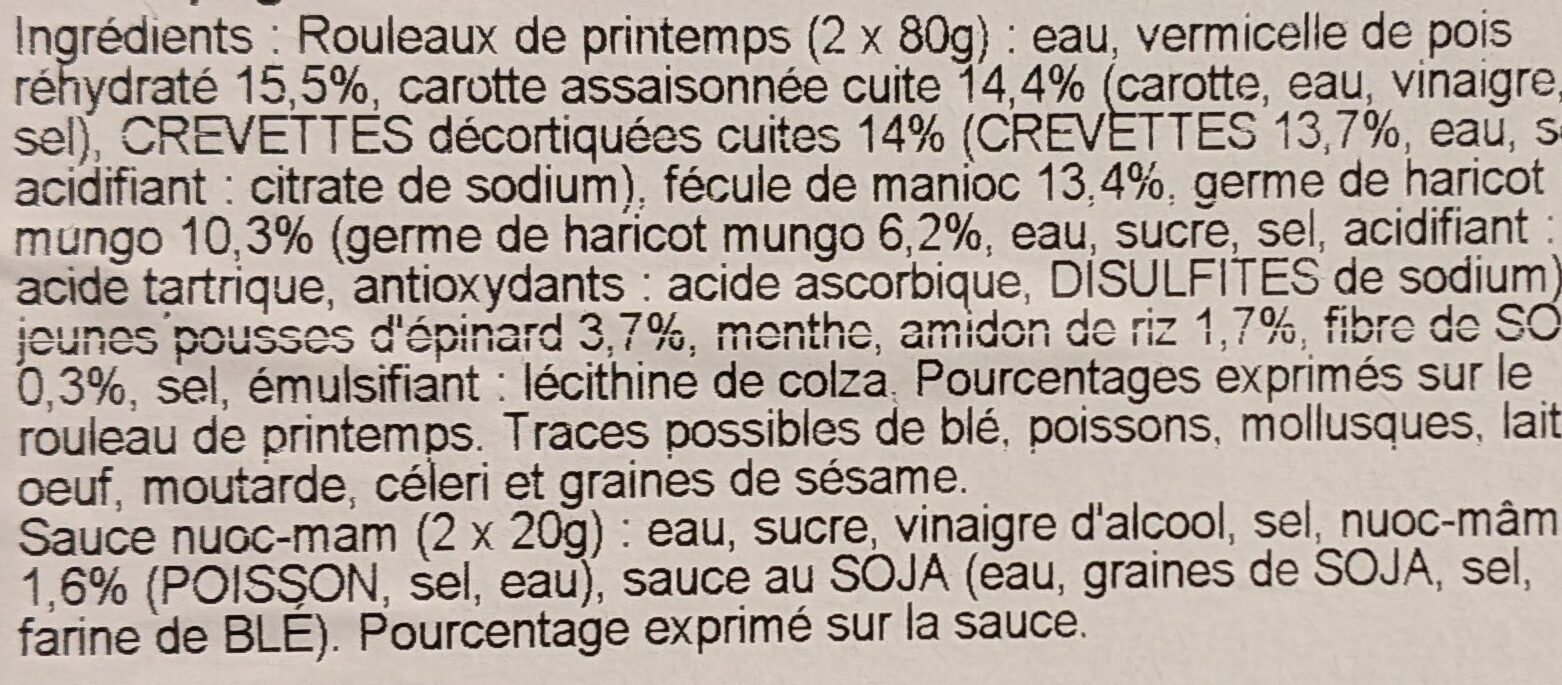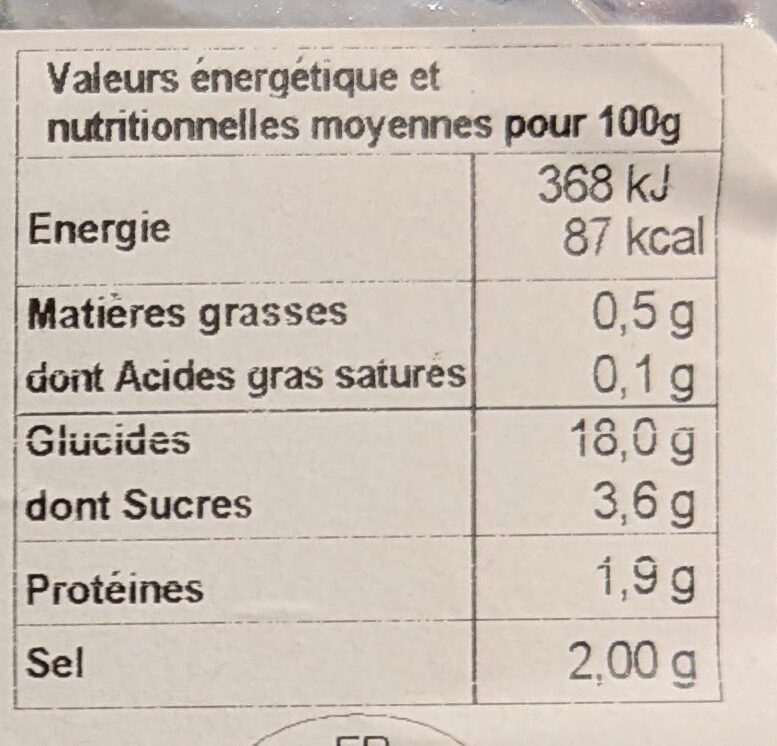Help us make food transparency the norm!
As a non-profit organization, we depend on your donations to continue informing consumers around the world about what they eat.
The food revolution starts with you!
2 Rouleaux de printemps crevettes - Agis - 200 g
2 Rouleaux de printemps crevettes - Agis - 200 g
This product page is not complete. You can help to complete it by editing it and adding more data from the photos we have, or by taking more photos using the app for Android or iPhone/iPad. Thank you!
×
Barcode: 3366760023114 (EAN / EAN-13)
Quantity: 200 g
Packaging: Plastic, Fresh, Tray
Brands: Agis
Categories: Meals, Fresh foods, Fresh meals, Nems, Spring rolls
Labels, certifications, awards:
No preservatives, Green Dot, No colorings
Manufacturing or processing places: France
Traceability code: FR 44.072.002 CE - Herbignac (Loire-Atlantique, France)
Stores: Carrefour, carrefour.fr
Countries where sold: France
Matching with your preferences
Health
Ingredients
-
46 ingredients
French: Rouleaux de printemps (2 x 80g): eau, vermicelle de pois réhydraté 15,5%, carotte assaisonnée cuite 14,4% (carotte, eau, vinaigre. sel), CREVETTES décortiquées cuites 14% (CREVETTES 13,7%, eau, acidifiant: citrate de sodium), fécule de manioc 13,4%, germe de haricot mungo 10,3% (germe de haricot mungo 6,2%, eau, sucre, sel, acidifiant acide tartrique, antioxydants: acide ascorbique, DISULFITES de sodium) jeunes pousses d'épinard 3,7%, menthe, amidon de riz 1,7%, fibre de SO 0,3%, sel, émulsifiant lécithine de colza. Pourcentages exprimés sur le rouleau de printemps. Sauce nuoc-mam (2 x 20g) : eau, sucre, vinaigre d'alcool, sel, nuoc-mâm 1,6% (POISSON, sel, eau), sauce au SOJA (eau, graines de SOJA, sel, farine de BLE). Pourcentage exprimé sur la sauce.Allergens: Crustaceans, Fish, Gluten, Soybeans, Sulphur dioxide and sulphitesTraces: Celery, Eggs, Fish, Gluten, Milk, Molluscs, Mustard, Sesame seeds
Food processing
-
Processed foods
Elements that indicate the product is in the 3 - Processed foods group:
- Category: Meals
- Ingredient: Salt
- Ingredient: Starch
- Ingredient: Sugar
- Ingredient: Sauce
Food products are classified into 4 groups according to their degree of processing:
- Unprocessed or minimally processed foods
- Processed culinary ingredients
- Processed foods
- Ultra processed foods
The determination of the group is based on the category of the product and on the ingredients it contains.
Additives
-
E223 - Sodium metabisulphite
Sodium metabisulfite: Sodium metabisulfite or sodium pyrosulfite -IUPAC spelling; Br. E. sodium metabisulphite or sodium pyrosulphite- is an inorganic compound of chemical formula Na2S2O5. The substance is sometimes referred to as disodium metabisulfite. It is used as a disinfectant, antioxidant, and preservative agent.Source: Wikipedia
-
E331 - Sodium citrates
Sodium citrate: Sodium citrate may refer to any of the sodium salts of citrate -though most commonly the third-: Monosodium citrate Disodium citrate Trisodium citrateThe three forms of the salt are collectively known by the E number E331. Sodium citrates are used as acidity regulators in food and drinks, and also as emulsifiers for oils. They enable cheeses to melt without becoming greasy.Source: Wikipedia
-
E334 - L(+)-tartaric acid
Tartaric acid: Tartaric acid is a white, crystalline organic acid that occurs naturally in many fruits, most notably in grapes, but also in bananas, tamarinds, and citrus. Its salt, potassium bitartrate, commonly known as cream of tartar, develops naturally in the process of winemaking. It is commonly mixed with sodium bicarbonate and is sold as baking powder used as a leavening agent in food preparation. The acid itself is added to foods as an antioxidant and to impart its distinctive sour taste. Tartaric is an alpha-hydroxy-carboxylic acid, is diprotic and aldaric in acid characteristics, and is a dihydroxyl derivative of succinic acid.Source: Wikipedia
Ingredients analysis
-
Palm oil content unknown
Unrecognized ingredients: fr:rouleaux-de-printemps, fr:2-x, fr:carotte-assaisonnee-cuite, fr:fibre-de-so, fr:emulsifiant-lecithine-de-colza, fr:2-xSome ingredients could not be recognized.
We need your help!
You can help us recognize more ingredients and better analyze the list of ingredients for this product and others:
- Edit this product page to correct spelling mistakes in the ingredients list, and/or to remove ingredients in other languages and sentences that are not related to the ingredients.
- Add new entries, synonyms or translations to our multilingual lists of ingredients, ingredient processing methods, and labels.
If you would like to help, join the #ingredients channel on our Slack discussion space and/or learn about ingredients analysis on our wiki. Thank you!
-
Non-vegan
Non-vegan ingredients: fr:Crevettes décortiquées, Shrimp, Nuoc-mam, Nuoc-mam, FishSome ingredients could not be recognized.
We need your help!
You can help us recognize more ingredients and better analyze the list of ingredients for this product and others:
- Edit this product page to correct spelling mistakes in the ingredients list, and/or to remove ingredients in other languages and sentences that are not related to the ingredients.
- Add new entries, synonyms or translations to our multilingual lists of ingredients, ingredient processing methods, and labels.
If you would like to help, join the #ingredients channel on our Slack discussion space and/or learn about ingredients analysis on our wiki. Thank you!
-
Non-vegetarian
Non-vegetarian ingredients: fr:Crevettes décortiquées, Shrimp, Nuoc-mam, Nuoc-mam, FishSome ingredients could not be recognized.
We need your help!
You can help us recognize more ingredients and better analyze the list of ingredients for this product and others:
- Edit this product page to correct spelling mistakes in the ingredients list, and/or to remove ingredients in other languages and sentences that are not related to the ingredients.
- Add new entries, synonyms or translations to our multilingual lists of ingredients, ingredient processing methods, and labels.
If you would like to help, join the #ingredients channel on our Slack discussion space and/or learn about ingredients analysis on our wiki. Thank you!
-
Details of the analysis of the ingredients
We need your help!
Some ingredients could not be recognized.
We need your help!
You can help us recognize more ingredients and better analyze the list of ingredients for this product and others:
- Edit this product page to correct spelling mistakes in the ingredients list, and/or to remove ingredients in other languages and sentences that are not related to the ingredients.
- Add new entries, synonyms or translations to our multilingual lists of ingredients, ingredient processing methods, and labels.
If you would like to help, join the #ingredients channel on our Slack discussion space and/or learn about ingredients analysis on our wiki. Thank you!
fr: Rouleaux de printemps (2 x, eau), vermicelle de pois réhydraté 15.5%, carotte assaisonnée cuite 14.4% (carotte, eau, vinaigre, sel), CREVETTES décortiquées 14% (CREVETTES 13.7%, eau, acidifiant (citrate de sodium)), fécule de manioc 13.4%, germe de haricot mungo 10.3% (germe de haricot mungo 6.2%, eau, sucre, sel, acidifiant (acide tartrique), antioxydants (acide ascorbique), DISULFITES de sodium), jeunes pousses d'épinard 3.7%, menthe, amidon de riz 1.7%, fibre de SO 0.3%, sel, émulsifiant lécithine de colza, Sauce nuoc-mam (2 x, eau), sucre, vinaigre d'alcool, sel, nuoc-mâm 1.6% (POISSON, sel, eau), sauce au SOJA (eau, graines de SOJA, sel, farine de BLE)- Rouleaux de printemps -> fr:rouleaux-de-printemps
- 2 x -> fr:2-x
- eau -> en:water - vegan: yes - vegetarian: yes - ciqual_food_code: 18066
- vermicelle de pois réhydraté -> fr:vermicelle-de-pois-rehydrate - percent: 15.5
- carotte assaisonnée cuite -> fr:carotte-assaisonnee-cuite - percent: 14.4
- carotte -> en:carrot - vegan: yes - vegetarian: yes - ciqual_food_code: 20009
- eau -> en:water - vegan: yes - vegetarian: yes - ciqual_food_code: 18066
- vinaigre -> en:vinegar - vegan: yes - vegetarian: yes - ciqual_food_code: 11018
- sel -> en:salt - vegan: yes - vegetarian: yes - ciqual_food_code: 11058
- CREVETTES décortiquées -> fr:crevettes-decortiquees - vegan: no - vegetarian: no - ciqual_food_code: 10021 - percent: 14
- CREVETTES -> en:shrimp - vegan: no - vegetarian: no - ciqual_food_code: 10021 - percent: 13.7
- eau -> en:water - vegan: yes - vegetarian: yes - ciqual_food_code: 18066
- acidifiant -> en:acid
- citrate de sodium -> en:sodium-citrate
- fécule de manioc -> en:tapioca - vegan: yes - vegetarian: yes - ciqual_proxy_food_code: 9510 - percent: 13.4
- germe de haricot mungo -> en:mung-bean-sprout - vegan: yes - vegetarian: yes - ciqual_food_code: 20183 - percent: 10.3
- germe de haricot mungo -> en:mung-bean-sprout - vegan: yes - vegetarian: yes - ciqual_food_code: 20183 - percent: 6.2
- eau -> en:water - vegan: yes - vegetarian: yes - ciqual_food_code: 18066
- sucre -> en:sugar - vegan: yes - vegetarian: yes - ciqual_proxy_food_code: 31016
- sel -> en:salt - vegan: yes - vegetarian: yes - ciqual_food_code: 11058
- acidifiant -> en:acid
- acide tartrique -> en:e334 - vegan: yes - vegetarian: yes
- antioxydants -> en:antioxidant
- acide ascorbique -> en:e300 - vegan: yes - vegetarian: yes
- DISULFITES de sodium -> en:e221 - vegan: yes - vegetarian: yes
- jeunes pousses d'épinard -> en:baby-spinach - vegan: yes - vegetarian: yes - ciqual_food_code: 20059 - percent: 3.7
- menthe -> en:mint - vegan: yes - vegetarian: yes - ciqual_food_code: 11027
- amidon de riz -> en:rice-starch - vegan: yes - vegetarian: yes - ciqual_proxy_food_code: 9510 - percent: 1.7
- fibre de SO -> fr:fibre-de-so - percent: 0.3
- sel -> en:salt - vegan: yes - vegetarian: yes - ciqual_food_code: 11058
- émulsifiant lécithine de colza -> fr:emulsifiant-lecithine-de-colza
- Sauce nuoc-mam -> en:nuoc-mam - vegan: no - vegetarian: no - ciqual_food_code: 11194
- 2 x -> fr:2-x
- eau -> en:water - vegan: yes - vegetarian: yes - ciqual_food_code: 18066
- sucre -> en:sugar - vegan: yes - vegetarian: yes - ciqual_proxy_food_code: 31016
- vinaigre d'alcool -> en:alcohol-vinegar - vegan: yes - vegetarian: yes - ciqual_food_code: 11018
- sel -> en:salt - vegan: yes - vegetarian: yes - ciqual_food_code: 11058
- nuoc-mâm -> en:nuoc-mam - vegan: no - vegetarian: no - ciqual_food_code: 11194 - percent: 1.6
- POISSON -> en:fish - vegan: no - vegetarian: no - ciqual_proxy_food_code: 26140
- sel -> en:salt - vegan: yes - vegetarian: yes - ciqual_food_code: 11058
- eau -> en:water - vegan: yes - vegetarian: yes - ciqual_food_code: 18066
- sauce au SOJA -> en:soy-sauce - vegan: maybe - vegetarian: maybe - ciqual_food_code: 11104
- eau -> en:water - vegan: yes - vegetarian: yes - ciqual_food_code: 18066
- graines de SOJA -> en:soya-bean - vegan: yes - vegetarian: yes - ciqual_food_code: 20901
- sel -> en:salt - vegan: yes - vegetarian: yes - ciqual_food_code: 11058
- farine de BLE -> en:wheat-flour - vegan: yes - vegetarian: yes - ciqual_proxy_food_code: 9410
Nutrition
-
Average nutritional quality
⚠ ️Warning: the amount of fiber is not specified, their possible positive contribution to the grade could not be taken into account.⚠ ️Warning: the amount of fruits, vegetables and nuts is not specified on the label, it was estimated from the list of ingredients: 21This product is not considered a beverage for the calculation of the Nutri-Score.
Positive points: 1
- Proteins: 1 / 5 (value: 1.9, rounded value: 1.9)
- Fiber: 0 / 5 (value: 0, rounded value: 0)
- Fruits, vegetables, nuts, and colza/walnut/olive oils: 0 / 5 (value: 21.2, rounded value: 21.2)
Negative points: 9
- Energy: 1 / 10 (value: 368, rounded value: 368)
- Sugars: 0 / 10 (value: 3.6, rounded value: 3.6)
- Saturated fat: 0 / 10 (value: 0.1, rounded value: 0.1)
- Sodium: 8 / 10 (value: 800, rounded value: 800)
The points for proteins are counted because the negative points are less than 11.
Nutritional score: (9 - 1)
Nutri-Score:
-
Nutrient levels
-
Fat in low quantity (0.5%)
What you need to know- A high consumption of fat, especially saturated fats, can raise cholesterol, which increases the risk of heart diseases.
Recommendation: Limit the consumption of fat and saturated fat- Choose products with lower fat and saturated fat content.
-
Saturated fat in low quantity (0.1%)
What you need to know- A high consumption of fat, especially saturated fats, can raise cholesterol, which increases the risk of heart diseases.
Recommendation: Limit the consumption of fat and saturated fat- Choose products with lower fat and saturated fat content.
-
Sugars in low quantity (3.6%)
What you need to know- A high consumption of sugar can cause weight gain and tooth decay. It also augments the risk of type 2 diabetes and cardio-vascular diseases.
Recommendation: Limit the consumption of sugar and sugary drinks- Sugary drinks (such as sodas, fruit beverages, and fruit juices and nectars) should be limited as much as possible (no more than 1 glass a day).
- Choose products with lower sugar content and reduce the consumption of products with added sugars.
-
Salt in high quantity (2%)
What you need to know- A high consumption of salt (or sodium) can cause raised blood pressure, which can increase the risk of heart disease and stroke.
- Many people who have high blood pressure do not know it, as there are often no symptoms.
- Most people consume too much salt (on average 9 to 12 grams per day), around twice the recommended maximum level of intake.
Recommendation: Limit the consumption of salt and salted food- Reduce the quantity of salt used when cooking, and don't salt again at the table.
- Limit the consumption of salty snacks and choose products with lower salt content.
-
-
Nutrition facts
Nutrition facts As sold
for 100 g / 100 mlAs sold
per serving (100g)Compared to: Spring rolls Energy 368 kj
(87 kcal)368 kj
(87 kcal)-53% Fat 0.5 g 0.5 g -93% Saturated fat 0.1 g 0.1 g -91% Carbohydrates 18 g 18 g -25% Sugars 3.6 g 3.6 g -11% Fiber ? ? Proteins 1.9 g 1.9 g -59% Salt 2 g 2 g +67% Fruits‚ vegetables‚ nuts and rapeseed‚ walnut and olive oils (estimate from ingredients list analysis) 21.2 % 21.2 %
Environment
-
Eco-Score C - Moderate environmental impact
⚠ ️Select a country in order to include the full impact of transportation.The Eco-Score is an experimental score that summarizes the environmental impacts of food products.→ The Eco-Score was initially developped for France and it is being extended to other European countries. The Eco-Score formula is subject to change as it is regularly improved to make it more precise and better suited to each country.Life cycle analysis
-
Average impact of products of the same category: B (Score: 72/100)
Category: Spring roll
Category: Spring roll
- PEF environmental score: 0.33 (the lower the score, the lower the impact)
- including impact on climate change: 2.33 kg CO2 eq/kg of product
Stage Impact Agriculture
62.7 %Processing
11.0 %Packaging
5.4 %Transportation
8.0 %Distribution
2.7 %Consumption
10.2 %
Bonuses and maluses
-
Missing origins of ingredients information
Malus: -5
⚠ ️ The origins of the ingredients of this product are not indicated.
If they are indicated on the packaging, you can modify the product sheet and add them.
If you are the manufacturer of this product, you can send us the information with our free platform for producers.
-
Packaging with a high impact
Malus: -15
Shape Material Recycling Impact 1 Tray Plastic Recycle High 1 Seal Plastic Recycle High 1 Individual dose Plastic Recycle High ⚠ ️ The information about the packaging of this product is not sufficiently precise (exact shapes and materials of all components of the packaging).⚠ ️ For a more precise calculation of the Eco-Score, you can modify the product page and add them.
If you are the manufacturer of this product, you can send us the information with our free platform for producers.
Eco-Score for this product
-
Impact for this product: C (Score: 52/100)
Product: 2 Rouleaux de printemps crevettes - Agis - 200 g
Life cycle analysis score: 72
Sum of bonuses and maluses: -20
Final score: 52/100
-
Carbon footprint
-
Equal to driving 1.2 km in a petrol car
233 g CO² per 100g of product
The carbon emission figure comes from ADEME's Agribalyse database, for the category: Spring roll (Source: ADEME Agribalyse Database)
Stage Impact Agriculture
60.2 %Processing
9.1 %Packaging
11.9 %Transportation
13.3 %Distribution
1.6 %Consumption
4.0 %
Packaging
-
Packaging with a high impact
-
Packaging parts
1 x Tray (Plastic)
1 x Seal (Plastic)
1 x Individual dose (Plastic)
-
Packaging materials
Material % Packaging weight Packaging weight per 100 g of product Plastic
-
Transportation
-
Origins of ingredients
Missing origins of ingredients information
⚠ ️ The origins of the ingredients of this product are not indicated.
If they are indicated on the packaging, you can modify the product sheet and add them.
If you are the manufacturer of this product, you can send us the information with our free platform for producers.Add the origins of ingredients for this product Add the origins of ingredients for this product
Report a problem
-
Incomplete or incorrect information?
Category, labels, ingredients, allergens, nutritional information, photos etc.
If the information does not match the information on the packaging, please complete or correct it. Open Food Facts is a collaborative database, and every contribution is useful for all.
Data sources
Product added on by openfoodfacts-contributors
Last edit of product page on by roboto-app.
Product page also edited by autorotate-bot, beniben, date-limite-app, driveoff, ecoscore-impact-estimator, feat, fgouget, foodvisor, g123k, kiliweb, packbot, philanne, sebleouf, tacite, yuka.R3E5Ykw1eGMvdUFVdnYwNzN5bjN3Tmg4K0pTTWZHS2xJdlFhSVE9PQ, yuka.UjRSY041MGp2ZFlOdVBNYW8welQrOVF0K1pxWGJGNmxMczVJSVE9PQ, yuka.UjZjS05iZ2xtL1VUbHNJZitVL1UyYzk3bUw2UlUyMnJDdVFUSWc9PQ, yuka.Wkk0bk4vZ0RxK0VFb00wdXp4VEZ3TTh0MzZLR2ZHNlVEckpQSVE9PQ, yuka.YWJzR0w2QWVtZEFGdThaaHdSUGFxc05UMlpPN0JrV1VGTUErSUE9PQ, yuka.sY2b0xO6T85zoF3NwEKvlhV1DdbwqS_9EBnnsl-3yOytDrXLMYt7-IrZNKg, yuka.sY2b0xO6T85zoF3NwEKvlhxGcf7Mox-cLAPRpUqOm4nXCMXYX_pe_or4Gas, yuka.sY2b0xO6T85zoF3NwEKvllAYDMjTk27vaBHWpm-729aQcpfCUYlg2bDQM6g.












